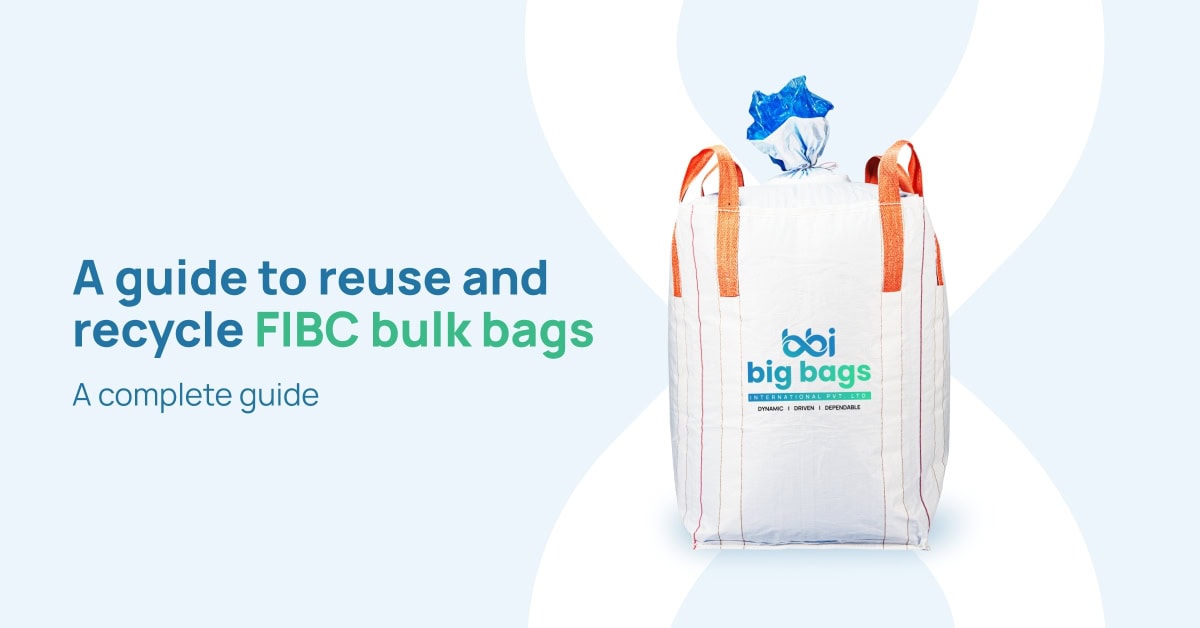A Guide To Reuse and Recycle FIBC Bulk Bags

FIBC bulk bags have a longer lifespan than traditional packaging containers. And owing to the nature of the material used in making these bags, they’re economical, sustainable, reusable, and recyclable.
Every business using FIBC bulk bags should follow a certain set of guidelines to reuse and recycle the bags.
The following blog is a handy guide that reviews these guidelines and outlines when and how you can reuse and recycle FIBC bulk bags.
Steps To Reuse FIBC Bulk Bag
FIBC bulk bags help reduce the company’s environmental footprint by reducing wastage and transportation costs while delivering safe and reliable storage for business. These bags are easy to clean, store, stack, and reuse.
Following best practices for cleaning, inspecting, and repairing FIBC bags before reuse ensures that the product remains in optimal condition until the endpoint.
The following are the key guidelines, as suggested by the Flexible Intermediate Bulk Container Association (FIBCA), for standardizing the reuse and recycling of FIBC bags.
1. Cleaning
Before reusing the FIBC bulk bag, clean it thoroughly to remove any residue and replace the liners if contaminated. You can use a pressure washer, brush, or cloth with water to clean the bag.
2. Inspection
Before reusing, conduct a thorough inspection for signs of damage. Look for tears, holes, and frayed edges that may compromise its strength and safety. If the bag is damaged, it’s unfit for reuse and may be repaired or recycled instead.
3. Sorting
The bag’s safety standard is compromised if the bag is contaminated or the lifting strap is damaged. Similarly, dampness, embedded wood splinters, mould or mildew growth, and smeared or unreadable printing are all criteria for the bag to be rejected for reusing.
4. Reconditioning
Minor damages found during inspection can be repaired to recondition the bag. Repairs such as patching holes or tears, reinforcing seams or lifting loops, and replacing damaged closures, labels, web ties, and cord locks help extend the lifespan of the FIBC bulk bag.
5. Tracking
The stock manager should maintain a diligent record of origin, duration of use, products packed, the quantity carried, reuse number, etc., to track the lifespan of the FIBC bulk bag.
6. Testing
As a safety precaution, bulk bags should be randomly selected for top lift testing. The frequency and quantity should be determined by the manufacturer or user based on their specific situation.
7. Repackaging
The bags are labelled with appropriate information such as weight capacity, handling instructions, and safety warnings before being repackaged and stored until ready for reuse.
Recycling FIBC Bulk Bags
FIBC bulk bags are made from virgin polypropylene, which is a common plastic that can be reprocessed into other plastic products. PP material can be processed again and again without losing much structural integrity.
Used FIBC bulk bags are collected in large quantities by industrial recycling companies; therefore, recycling is feasible for businesses that use large quantities of bags or ones that can store bags over time.
How Are FIBC Bulk Bags Recycled?
Here’s how FIBC bulk bags are recycled:
- Collection: Bulk bags are collected in compacted bales as they are cost-effective and easiest to handle.
- Classification:For recycling purposes, collected FIBC bulk bags are segregated into the following recycling grades:
- Grade A: Clean and bright white (coloured handles and stitching allowed).
- Grade B: Not as clean but still predominantly white with minimal colouring.
- Grade C: Coloured or may have dirty material.
- Sorting and Cleaning: Once segregated, the bulk bags are sorted according to previous usage and cleaned thoroughly of any residue.
- Shredding: The recycling facility will then use a shredder to reduce the bags into smaller flakes.
- Separation: The machine next separates the shredded bag material based on colour, size, light absorption, and shape and filters out contamination and impurities from the polymers.
- Compounding: In the final phase, the ground-up material is processed at a high temperature of 240℃ to recombine polymers and repurpose them for new applications.
Also Read : 7 Different Bulk Bag Discharge Types Explained
Responsible Use of FIBC bulk Bags
Taking responsibility for recycling and reusing FIBC bulk bags is a highly effective and simple way to promote a sustainable, economical, and waste-free business.
A bulk bag may only be recycled a fixed number of times, which shouldn’t be exceeded as it might prove dangerous to the business and the employees handling such bags.
With quality bags from a trusted and expert FIBC bag company, such as Big Bags International, you can increase the life of your FIBC bulk bags, save costs, and leave a smaller carbon footprint on the environment.
Over 1,000 clients worldwide have deemed Big Bags as one of the best FIBC bag manufacturers in India. Learn more about our complete range of FIBC bags, including the various types of jumbo FIBC bags, on our website.
